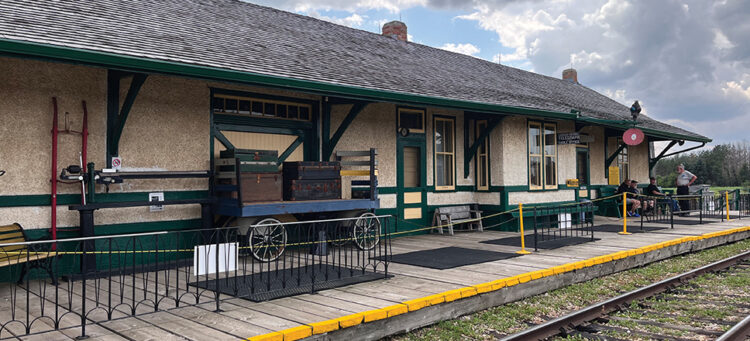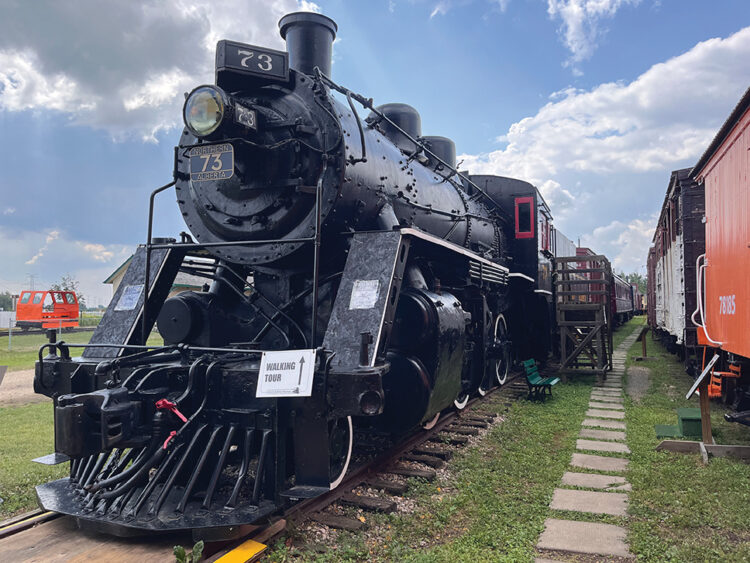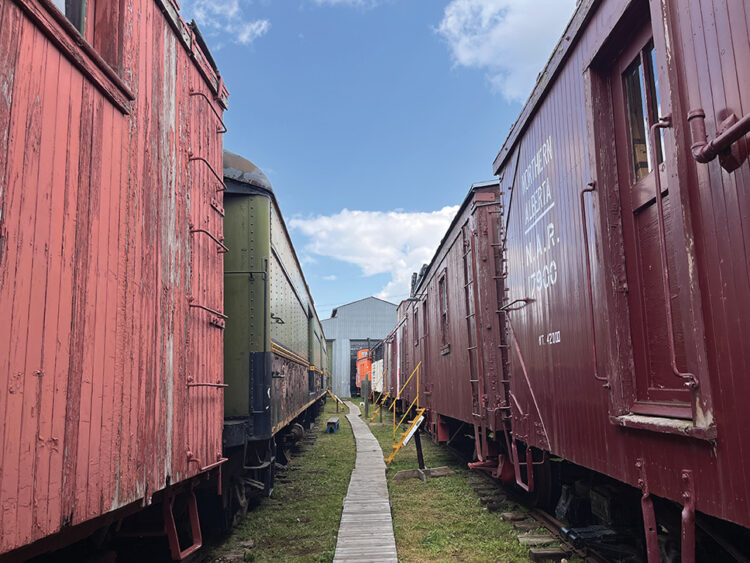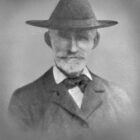
Then & Now
St.Albert Rail
Gene Kosowan
November, 2024
How trains helped St. Albert ride the rails to prosperity.
St. Albert has come a long way since its humble beginnings as a 19th century mission to a city of roughly 70,000. But the community didn’t just grow by itself. Events from the 1900s wheat boom to the oil gush of the Leduc No. 1 derrick in 1947 all played a part in the city’s development. Somehow ignored in tracing St. Albert’s progress has been its access to the railroad, which resulted in one of the first major spikes of economic activity in the city’s history.
1880s
Years before tracks were laid anywhere near St. Albert, locals almost exclusively relied on Red River cart brigades and horse-drawn carriages for supply and trading goods shipments. The trails made for tough slogging, especially during rainy days and the winter. Drier and warmer days weren’t much better, thanks to the wheel ruts imprinted by previous excursions.
So, village residents were understandably disappointed in 1882 that the Canadian Pacific Railway chose Calgary instead of nearby Edmonton as a stop for the first train to run through Alberta. The community would have to wait for nearly a decade before a railway would even reach the vicinity.
1890s
St. Albert finally received something remotely resembling access to locomotive-powered transit when the independently-operated Calgary and Edmonton Railway began operations in 1891. The railway, which would eventually be absorbed by Canadian Pacific, never actually reached Edmonton, instead stopping in the town of Strathcona, on the southern banks of the North Saskatchewan River. (Strathcona would eventually be absorbed by the Alberta capital in 1912.)
But hope lay in the prospects of the Edmonton & Slave Lake Railway, formed in 1899. Its eastern Canada owners, encouraged by the Yukon’s short-lived Klondike Gold Rush a year earlier, believed northern Alberta had enough natural resources to warrant building a line.
–

–
1900s
After several delays, construction of the Edmonton & Slave Lake line eventually reached St. Albert in 1906. The railroad also built a wooden trestle bridge across the Sturgeon River, and was open for business in 1908, with its train station starting service in 1909. The line, which stretched to the Athabasca region, was completed in 1912.
Once the line was commercially operational, St. Albert’s business community and farmers in the vicinity sighed with relief. No longer did they have to hit the cumbersome trail to Edmonton to market their grain and livestock and get supplies from retailers in that neighbouring community. All the wheeling and dealing could be done at the train station, while passengers loved the speed and the smoothness of the ride to Edmonton for shopping and entertainment. Almost overnight, St. Albert’s economy spiked with increased activity.
1910s
St. Albert merchants saw additional opportunity further west in 1910, when the Canadian Northern Railway bought out the Edmonton & Slave Lake Railway. Work quickly started on building a junction just north of town that would foster a rail line to British Columbia.
But a smaller, yet equally convenient service was also in the works. Three years later, the Interurban Railway, a passenger rail line connecting Edmonton and St. Albert, was established, using a Chicago-built trolley called the Drake. Unfortunately, the Drake broke down frequently, turning the Interurban Railway into a costly venture. Six months after starting, the company went under when the Drake was destroyed by fire
in 1914.
Also in 1914, the Alberta & Great Waterways Railway, previously incorporated in 1909, built another set of tracks heading north, with the nearest stop to St. Albert located in what is now Campbell Business Park. Sod for the project was first turned in 1913 just north of St. Albert in Carbondale,
the site of the line’s first train station.
1920s
Granted, towns like St. Albert economically benefited from the branch lines built in the province, but the companies running them weren’t as financially fortunate. They had to compete against Canadian Pacific which greatly profited from exclusively servicing larger municipalities. Unable to capture that considerably larger chunk of business, the smaller firms had to drastically restructure their operations.
Such was the case with the Canadian Northern and Grand Trunk Pacific railways, which merged with the newly-formed Canadian National Railway in 1920, and scrapped several branch lines in Alberta, although the original track that included St. Albert as a stop was mercifully untouched.
In 1929, another drastic merger took place, this time involving intervention from the provincial government. That year, a handful of companies that included the Alberta & Great Waterways Railway and the Edmonton, Dunvegan & British Columbia company united and formed Northern Alberta Railways.
–

–
1930s-1950s
Increasing traffic to the original train station resulted in periodical refurbishing of the building, which was refitted with more storage facilities. The terminal received a stucco and insulation treatment in 1937 and was serviced by electricity
in 1953.
The Second World War severely tested the capacity of the railway systems going through St. Albert. Wartime activity reached its height in 1942, when freight was hauled northward to supply the construction of the Canol Project, a pipeline designed to provide oil for Allies stationed in Alaska.
And while building of the railway in the region was remarkably casualty-free during the first half of the century, tragedy struck in 1959 at the Carbondale station, which was destroyed in the wake of a fiery head-on collision between a steam passenger train and a diesel freight train. The accident killed one person and injured 19 others.
1960s-Today
The railway system’s influence on transportation has gradually given way to the trucking industry, thanks to more improved roads and highways. In response, some rail companies folded or were taken over, as was the case of the Northern Alberta Railway, which was absorbed in 1981 by the Canadian National Railway, now rebranded as CN.
Passenger transport was limited to major lines when VIA Rail took over that part of the industry in 1978. But by then, St. Albert’s train station had been out of service for years and had since moved to the Alberta Railway Museum in 1973.
Today, CN operates the only rail line that bypasses St. Albert, where it spans northward to Hay River in the Northwest Territories. t8n
CPKC Holiday Train
All decked out for the festivities, the CPKC Holiday Train hits the rails once again as part of its massive food bank mission. Sadly, it won’t reach St. Albert, but watch for the train to stop on Dec. 12 at 8:15 p.m. at its station at 7935 Gateway Blvd. in Edmonton to take in non-perishable food items for needy families.













